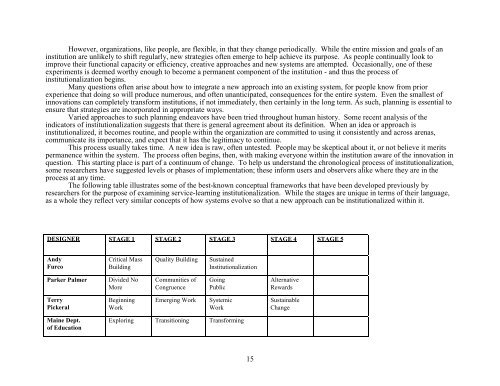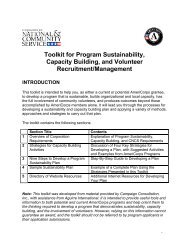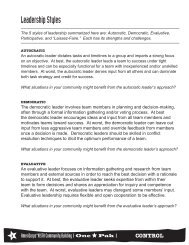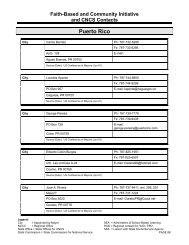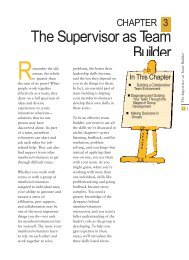MAKE IT LAST FOREVER: THE ... - National Service Resource Center
MAKE IT LAST FOREVER: THE ... - National Service Resource Center
MAKE IT LAST FOREVER: THE ... - National Service Resource Center
You also want an ePaper? Increase the reach of your titles
YUMPU automatically turns print PDFs into web optimized ePapers that Google loves.
However, organizations, like people, are flexible, in that they change periodically. While the entire mission and goals of an<br />
institution are unlikely to shift regularly, new strategies often emerge to help achieve its purpose. As people continually look to<br />
improve their functional capacity or efficiency, creative approaches and new systems are attempted. Occasionally, one of these<br />
experiments is deemed worthy enough to become a permanent component of the institution - and thus the process of<br />
institutionalization begins.<br />
Many questions often arise about how to integrate a new approach into an existing system, for people know from prior<br />
experience that doing so will produce numerous, and often unanticipated, consequences for the entire system. Even the smallest of<br />
innovations can completely transform institutions, if not immediately, then certainly in the long term. As such, planning is essential to<br />
ensure that strategies are incorporated in appropriate ways.<br />
Varied approaches to such planning endeavors have been tried throughout human history. Some recent analysis of the<br />
indicators of institutionalization suggests that there is general agreement about its definition. When an idea or approach is<br />
institutionalized, it becomes routine, and people within the organization are committed to using it consistently and across arenas,<br />
communicate its importance, and expect that it has the legitimacy to continue.<br />
This process usually takes time. A new idea is raw, often untested. People may be skeptical about it, or not believe it merits<br />
permanence within the system. The process often begins, then, with making everyone within the institution aware of the innovation in<br />
question. This starting place is part of a continuum of change. To help us understand the chronological process of institutionalization,<br />
some researchers have suggested levels or phases of implementation; these inform users and observers alike where they are in the<br />
process at any time.<br />
The following table illustrates some of the best-known conceptual frameworks that have been developed previously by<br />
researchers for the purpose of examining service-learning institutionalization. While the stages are unique in terms of their language,<br />
as a whole they reflect very similar concepts of how systems evolve so that a new approach can be institutionalized within it.<br />
DESIGNER STAGE 1 STAGE 2 STAGE 3 STAGE 4 STAGE 5<br />
Andy Critical Mass Quality Building Sustained<br />
Furco Building Institutionalization<br />
Parker Palmer Divided No Communities of Going Alternative<br />
More Congruence Public Rewards<br />
Terry Beginning Emerging Work Systemic Sustainable<br />
Pickeral Work Work Change<br />
Maine Dept.<br />
of Education<br />
Exploring Transitioning Transforming<br />
15


